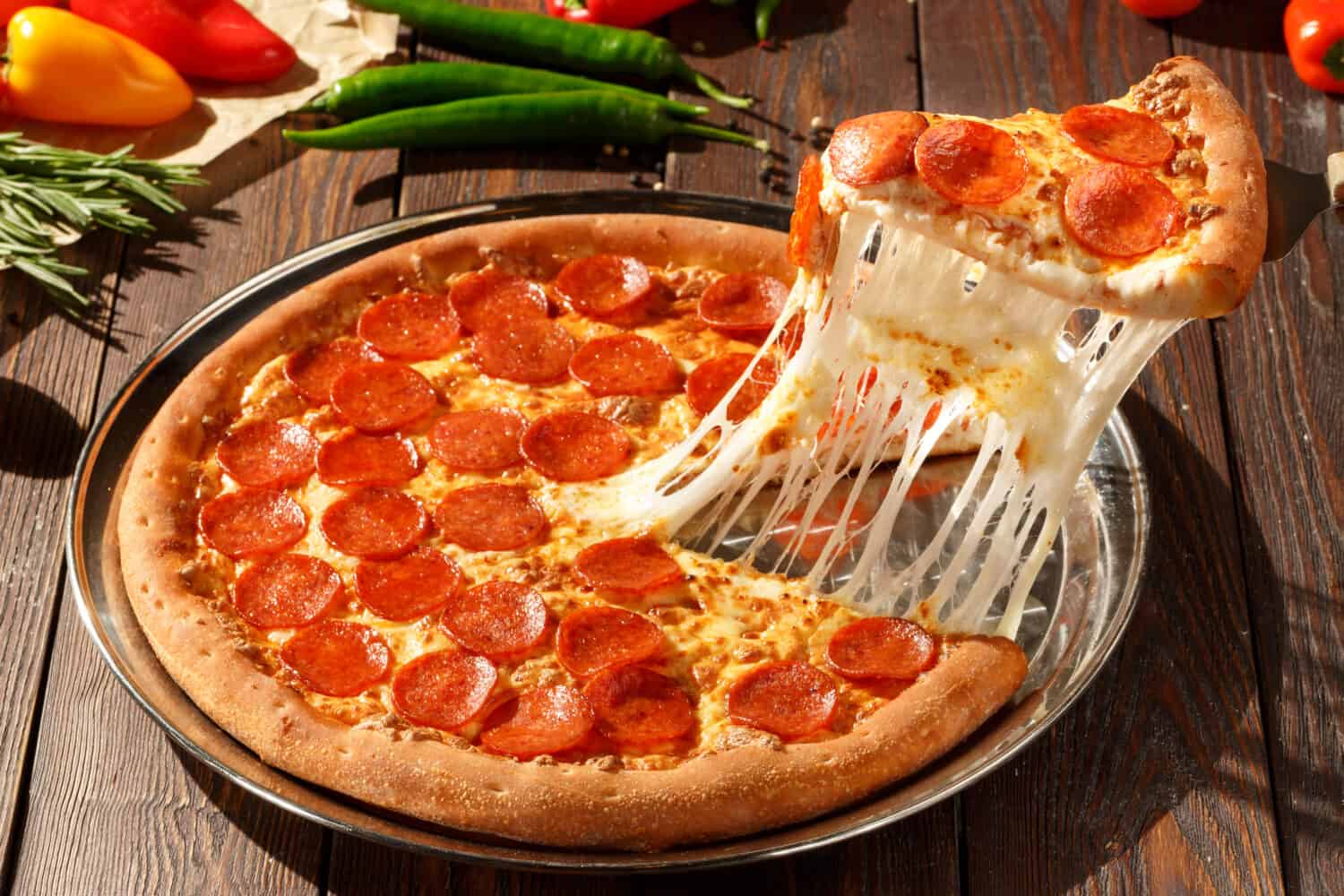Which is better? Salami or pepperoni? Are they interchangeable? Is one healthier than the other? Salami and pepperoni frequently appear on charcuterie boards, pizzas, and sandwiches. While both share a base of beef and pork, their textures, spices, and unique flavors set them apart. Let's look at what separates these meats and examine how they stack up nutritionally.
Salami vs. Pepperoni: What is salami?
Finely ground or coarsely chopped meats like beef, pork, or veal make up salami. Infused with herbs and spices, salami air dries and ferments. Moreover, natural or synthetic casings maintain the shape of the meat while it dries and ages. Additionally, salami ferments in a controlled environment, which results in salami's firm texture.
Salami takes several weeks, or even months, to age. Typically, salami slices are thin, frequently appearing in sandwiches, salads, and charcuterie boards. Additionally, salami is popular in calzones and Stromboli.
Types of salami
Salami has many variations, depending on the ingredients and what region it is from.
| Name | Description |
|---|---|
| Genoa Salami | This sweet and savory salami originated in Genoa, Italy. It's made from pork and seasoned with garlic, white or red wine, and black pepper. |
| Soppressata | This salami has two versions: sweet (dolce) and spice (piccante). It is medium-spicy. |
| Chorizo | Popular in Mexican and Spanish cuisine, chorizo has a bold and smoky taste because of the smoked paprika and garlic. |
| Cacciatore | Sometimes called “hunter's sausage,” it is a small salami from Italy. It is seasoned with garlic and black pepper and has a simple, rustic flavor. |
| Milani | Named after the Italian city, it's known for its fine grind and spices that give it a robust and savory taste. |
| Toscano | This salami has a hearty and traditional flavor. It is comprised of finely ground pork, garlic, red wine, and black pepper. |
| Felino | Named after a town in Italy, this salami has a mild and refined taste. It's made with lean pork and red wine. |
| Abruzzese | Hailing from the Italian region of Abruzzese, this salami has a medium-spicy flavor due to the garlic and red pepper spices. |
| Nduja | This fiery, spreadable salami originated in Calabria, Italy. |
| Crespone | This large salami with a robust and hearty flavor is from the Piedmont region in Italy. |
Salami vs. Pepperoni: What is pepperoni?
Pepperoni is the American version of salami. While many assume it originated in Italy, Italian immigrants in New York City created pepperoni. In the early 20th century, Italian butchers and pizzerias started serving it, but pepperoni remained an exotic pizza topping until the mid-twentieth century. It is now the most popular pizza topping in the United States. In contrast to America, pepperoni is not as wildly popular in Italy and the rest of the world.
The essential ingredients in pepperoni include minced beef, cured pork, and spices like paprika, red pepper, and garlic. Moreover, it is the paprika that gives pepperoni its recognizable reddish color. Most people are familiar with its texture, which is chewy, soft, and finely grained. In addition to its spicy flavoring and red color, it becomes slightly crispy during baking. This is one of the reasons it is so popular among pizza lovers.
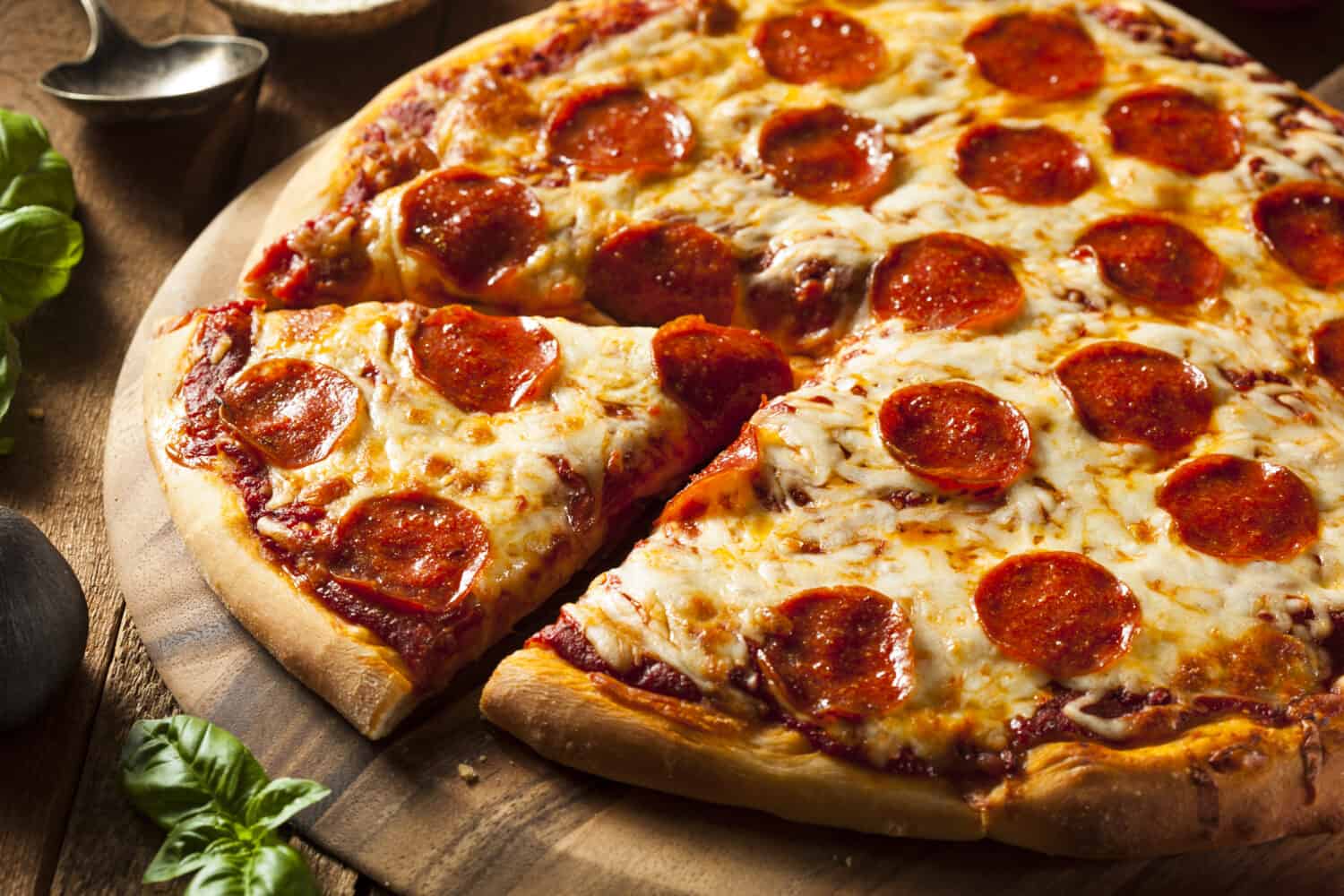
©Brent Hofacker/Shutterstock.com
Salami vs. Pepperoni: How are they different?
In addition to their countries of origin, these two cured meats differ in flavor, spices, texture, size, and shape. Moreover, salami has a wider range of flavors than pepperoni. Furthermore, wine is sometimes added to salami to enrich the flavor, whereas wine is rarely used in the preparation of pepperoni.
| Salami | Pepperoni | |
|---|---|---|
| Ingredients | Ground meat, fat, salt, spices, wine | Ground meat, fat, salt, paprika, chili peppers |
| Spices and Flavor | Varies widely, but usually includes fennel, garlic, and black pepper. Flavor varies but is usually rich and savory. | Paprika and chili peppers. Sometimes fennel seeds and garlic. Flavor is bold, spicy, and slightly tangy. |
| Texture | Firm, dense, and chewy, but varies. | Chewy, soft, crispy when baked. |
| Size and Shape | Varies widely, but typically thinly sliced. | Small, round. |
| Serving Methods | Antipasto, sandwiches, appetizers, salads, pasta dishes, and snacks. | Pizza, calzones, Stromboli, antipasto, snacks, and pasta dishes. |
Salami vs. Pepperoni: Ingredients and Flavor
While beef and pork make up both salami and pepperoni, the flavors are completely different. Moreover, the occasional addition of game meats and wine gives salami a complex and rich flavor. Wine, in particular, adds complexity and depth to the meat's taste. Moreover, salt is a crucial ingredient, not only for curing, but it balances salami's taste, texture, and enhances the other spices.
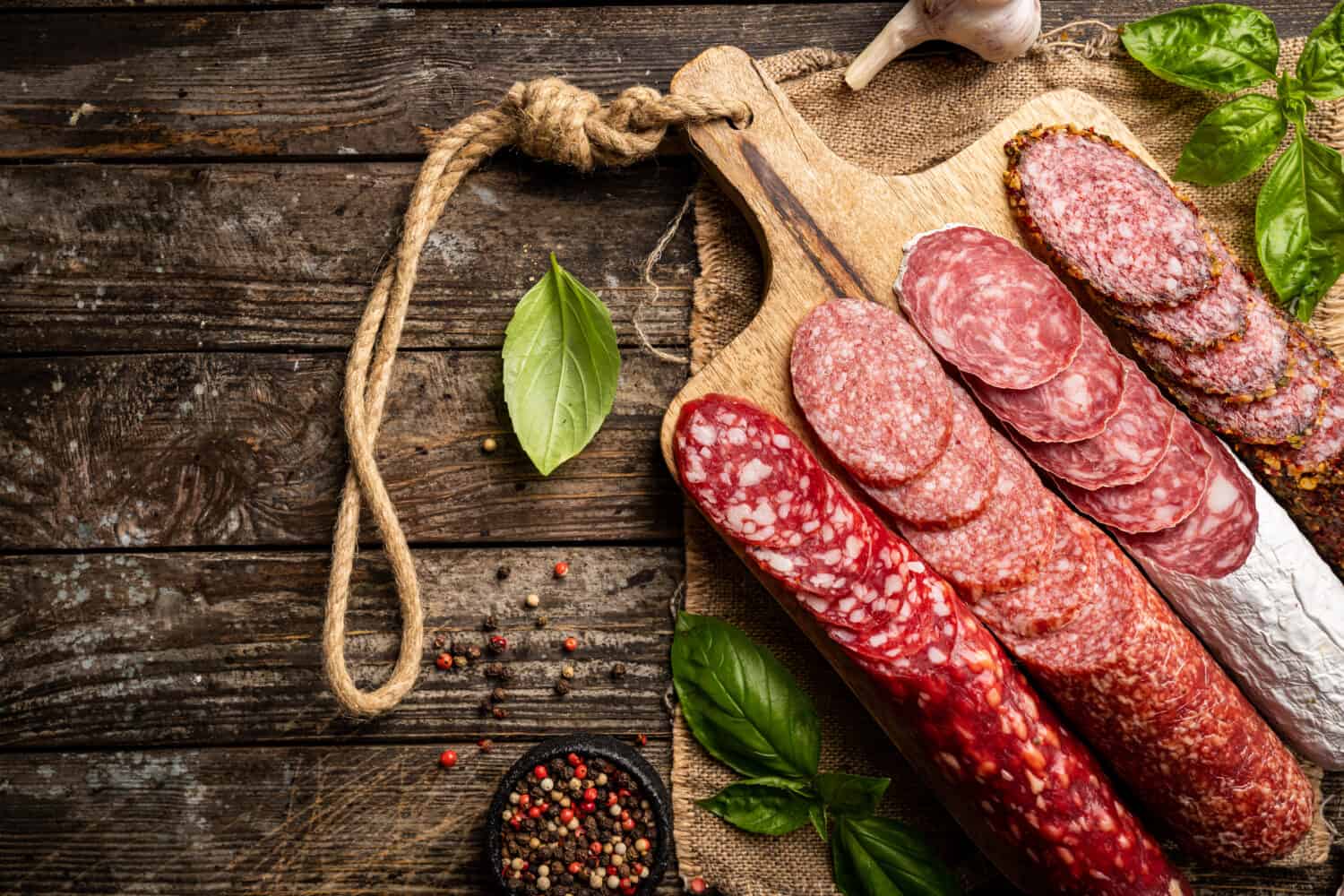
©Goskova Tatiana/Shutterstock.com
Salami vs Pepperoni: Nutritional Comparison
How do salami and pepperoni compare nutritionally? Is one healthier than the other? Well, it's not a simple explanation. Since both are classified as processed meats, which have been linked to an increased chance of developing heart disease and cancer, they are problematic. Unfortunately, each has a high amount of cholesterol and lots of sodium.
However, it's not all bad news. Salami is low in carbs and contains vitamins and minerals like niacin, vitamin B12, and zinc. Additionally, pepperoni has high amounts of vitamin B12 and selenium. Pepperoni and salami are protein powerhouses. Finally, both meats have a low glycemic index (GI).
Calories, fat, and protein
As mentioned previously, salami varies widely depending on the type of meat and ingredients used. However, on average, it contains 150-200 calories per ounce (28g). It's also rich in fat, with twelve to fifteen grams of fat per ounce. Additionally, it has a high protein content, containing around five to six grams per ounce.
Pepperoni also has a high fat and caloric intake. One ounce of pepperoni has approximately 170 calories. Additionally, each ounce has around fifteen grams of fat and almost seven grams of protein.
Sodium
Both types of cured meat have high amounts of sodium. In fact, the curing process of both salami and pepperoni contributes to the high sodium content. In fact, one serving of pepperoni equals 70% of the daily recommended intake. Pepperoni has 1582 mg of sodium per 100 gram serving while salami contains 1740 mg of sodium per serving.
Diet and weight loss
Due to their high fat and salt content, these meats are typically not part of a diet or weight loss program. However, for those eating a keto diet, both salami and pepperoni are okay due to their glycemic index and low carbohydrates. Moderation is the key for including both in your diet.
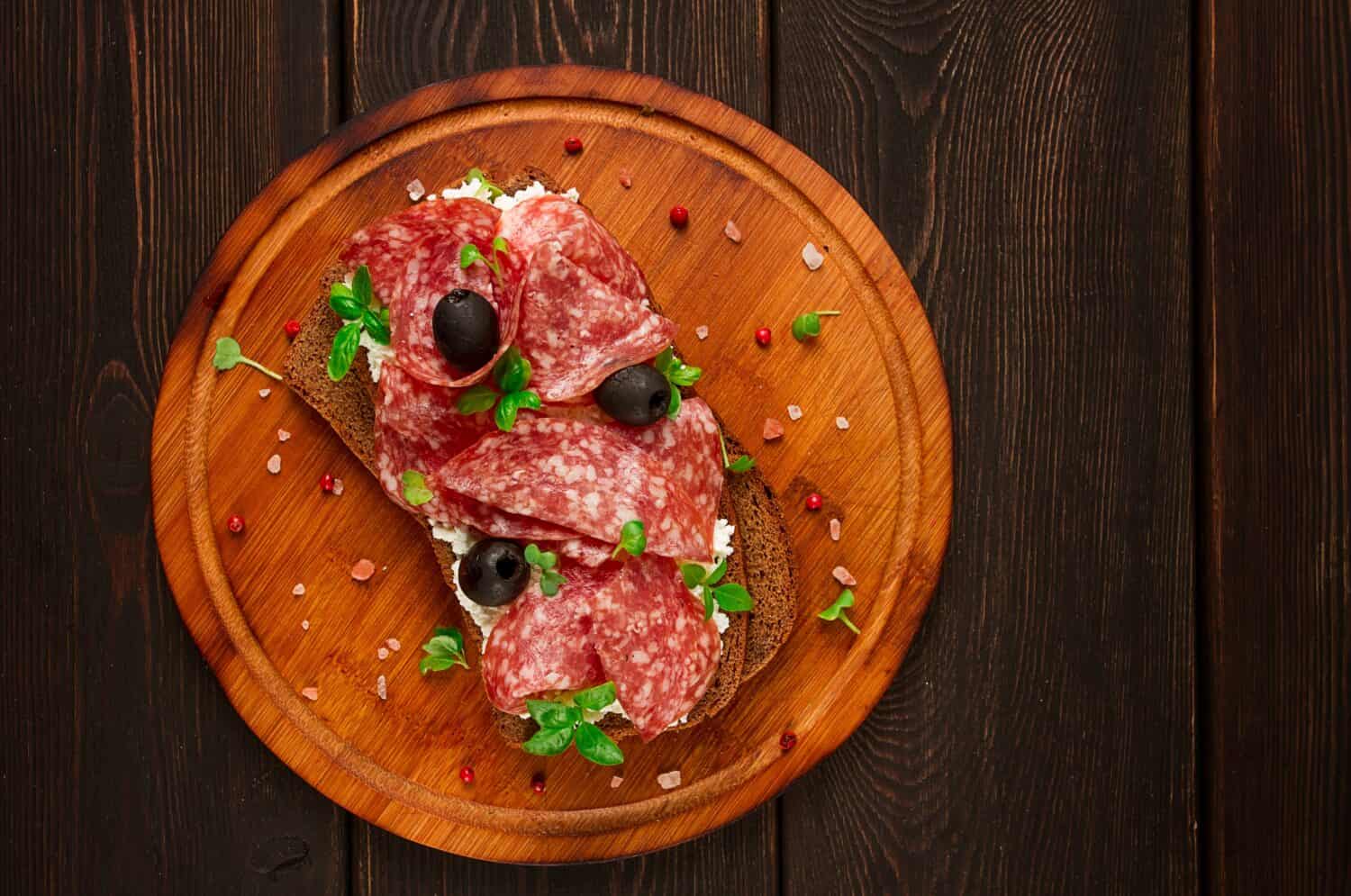
©Didebashvili.GEO/Shutterstock.com
Health Considerations
In general, there are several health considerations to consider regarding both salami and pepperoni.
- Both meats may trigger indigestion. If you suffer from acid reflux or digestive issues, they may worsen the symptoms.
- Since both have a lot of calories and fat, be mindful of portion control. It is a good idea to pair these meats with rich foods like whole grains, vegetables, and fruit. These meats do contain essential nutrients like protein, vitamins, and minerals, so they can be consumed as part of a well-rounded diet.
- If you have specific health concerns like heart disease or diabetes, consuming processed meat is linked to cardiovascular disease and type 2 diabetes. For those concerned about an increased risk of cancer, choosing nitrate-free or minimally processed meats may be an option.
One Final Note
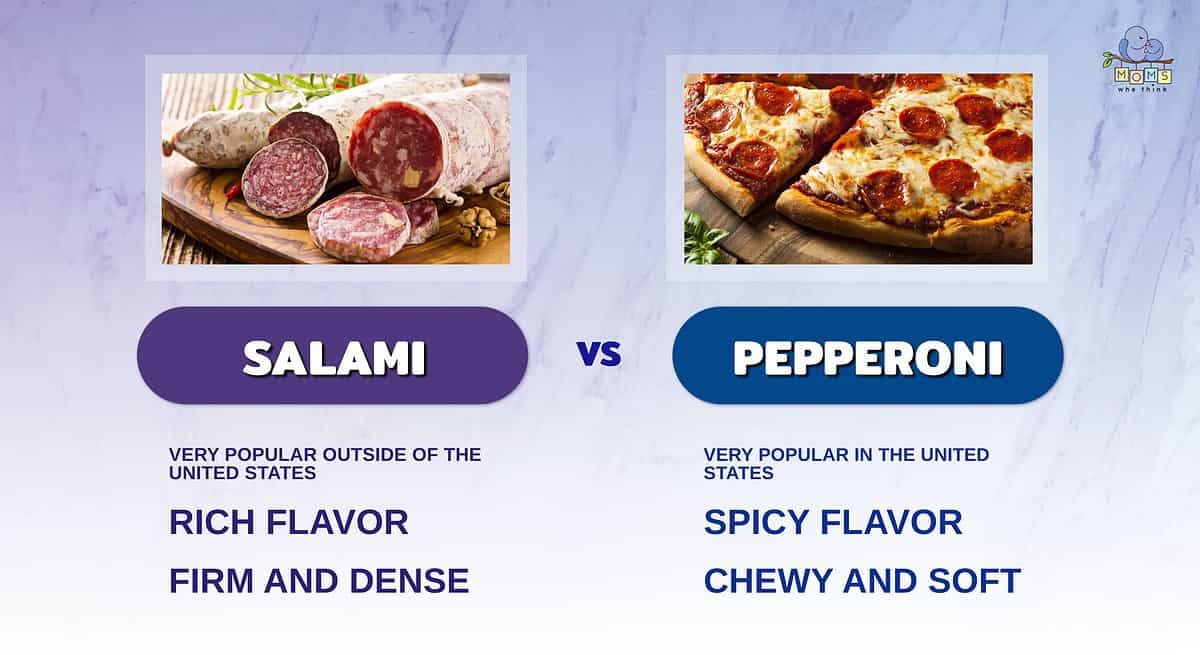
Salami and pepperoni have distinct flavors that make them unique. Originating in Italy, salami has a rich tradition, resulting in many variations. Pepperoni, with its Italian American origins, is famous for its spiciness. It also is America's favorite pizza topping.
When eating salami and pepperoni, consume them in moderation due to their high calories, fat, and preservatives. Luckily, they are both incredibly versatile meats that are popular in sandwiches, pizzas, and salads. If part of a balanced diet, you can enjoy both salami and pepperoni.
Try this awesome pepperoni pizza supreme:
Print
Pepperoni Pizza Supreme
- Yield: 6 slices 1x
Ingredients
1 prebaked 12 inch thin pizza crust
1 can (8 ounces) pizza sauce
1 Tablespoon grated Parmesan cheese
1 teaspoon Italian seasoning
1/2 teaspoon garlic powder
1/2 cup sliced fresh mushrooms
1/2 cup chopped fresh broccoli florets
1/4 cup chopped green pepper
1/4 cup chopped sweet red pepper
1/2 cup shredded reduced fat cheddar cheese
38 slices turkey pepperoni
1 cup (4 ounces) shredded part skim mozzarella cheese
Instructions
1. Place crust on an ungreased baking sheet. Spread with pizza sauce; sprinkle with the Parmesan cheese, Italian seasoning and garlic powder. Top with the mushrooms, broccoli and peppers.
2. Sprinkle with cheddar cheese. Top with pepperoni and mozzarella cheese. Bake at 400° for 14 to 18 minutes or until vegetables are crisp tender and cheese is melted.
Nutrition
- Serving Size: One slice
- Calories: 244
- Sodium: 698mg
- Fat: 9g
- Saturated Fat: 3g
- Carbohydrates: 26g
- Fiber: 1g
- Protein: 17g
- Cholesterol: 28mg
The image featured at the top of this post is ©www.petrovvladimir.ru/Shutterstock.com.
